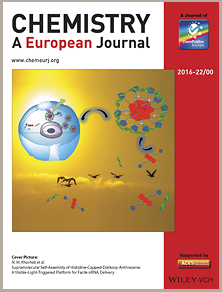

 Supramolecular self-assembly of histidine-capped-dialkoxy-anthracene (HDA) results in the formation of light-responsive nanostructures. Single-crystal X-ray diffraction analysis of HDA shows two types of hydrogen bonding. The first hydrogen bond is established between the imidazole moieties while the second involves the oxygen atom of one amide group and the hydrogen atom of a second amide group. When protonated in acidic aqueous media, HDA successfully complexes siRNA yielding spherical nanostructures. This biocompatible platform controllably delivers siRNA with high efficacy upon visible-light irradiation leading up to 90 % of gene silencing in live cells.
Supramolecular self-assembly of histidine-capped-dialkoxy-anthracene (HDA) results in the formation of light-responsive nanostructures. Single-crystal X-ray diffraction analysis of HDA shows two types of hydrogen bonding. The first hydrogen bond is established between the imidazole moieties while the second involves the oxygen atom of one amide group and the hydrogen atom of a second amide group. When protonated in acidic aqueous media, HDA successfully complexes siRNA yielding spherical nanostructures. This biocompatible platform controllably delivers siRNA with high efficacy upon visible-light irradiation leading up to 90 % of gene silencing in live cells.